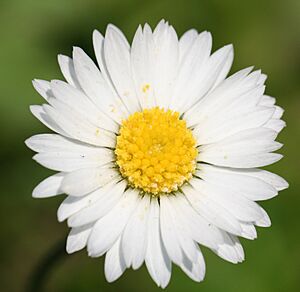Botanical name facts for kids
A botanical name is a special scientific name for plants, fungi, and algae. It's like a unique ID card for each type of plant! These names follow strict rules set by the International Code of Nomenclature for algae, fungi, and plants (ICN).
The main goal of a botanical name is to have one name that everyone around the world uses for a specific plant or plant group. This helps scientists, gardeners, and plant lovers communicate clearly, no matter what language they speak.
For example, the plant we call a "daisy" in English has many different names in other languages. In French, it's "pâquerette," and in German, it's "Gänseblümchen." But its botanical name is always Bellis perennis. This name is understood everywhere.
The rules for these names cover all kinds of plants, including ancient fossil plants, fungi (like mushrooms), and even tiny algae.
Sometimes, a plant is a special type grown by people, called a cultivar. For these, there are extra rules from the International Code of Nomenclature for Cultivated Plants. For instance, Bellis perennis 'Aucubifolia' is a specific type of daisy with golden leaves, chosen by gardeners.
Contents
How Botanical Names Are Made
Botanical names can have one, two, or three parts, depending on how specific the name needs to be.
One-Part Names
These names are used for very large groups, like families or genera (a group of closely related species).
- Plantae (This is the name for all plants!)
- Rosaceae (This is the rose family, which includes roses, apples, and strawberries.)
- Fragaria (This is the genus name for strawberries.)
Two-Part Names
These are the most common scientific names, especially for individual species. They are also called binary names.
- Citrus sinensis (This is the sweet orange species.)
- Bellis perennis (This is the common daisy species.)
A two-part name always includes:
- The genus name (like Bellis)
- A specific epithet (like perennis), which describes the species.
Three-Part Names
These names are used for plants that are even more specific than a species, like subspecies or varieties. They need a "connecting term" to show what kind of group they are.
- Calystegia sepium subsp. americana (This is a specific subspecies of American hedge bindweed.)
- Crataegus azarolus var. pontica (This is a variety of a Mediterranean hawthorn.)
For cultivated plants (cultivars), the third part is often in single quotes and not italicized. This part is usually not Latin.
- Bellis perennis 'Aucubifolia' (Here, 'Aucubifolia' is the cultivar name for a special daisy.)
Related Topics
- Biological classification (How living things are grouped)
- Binomial nomenclature (The system of two-part names)
- Taxonomy (The science of naming and classifying)
- Cultigen (A plant that has been changed by humans)
See also
 In Spanish: Nombre botánico para niños
In Spanish: Nombre botánico para niños


